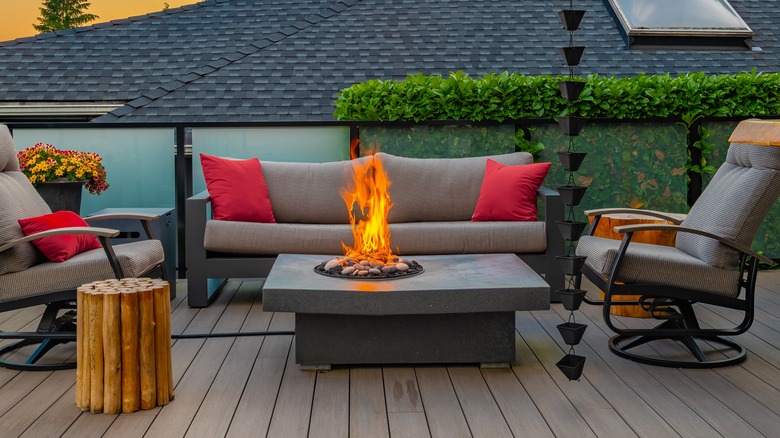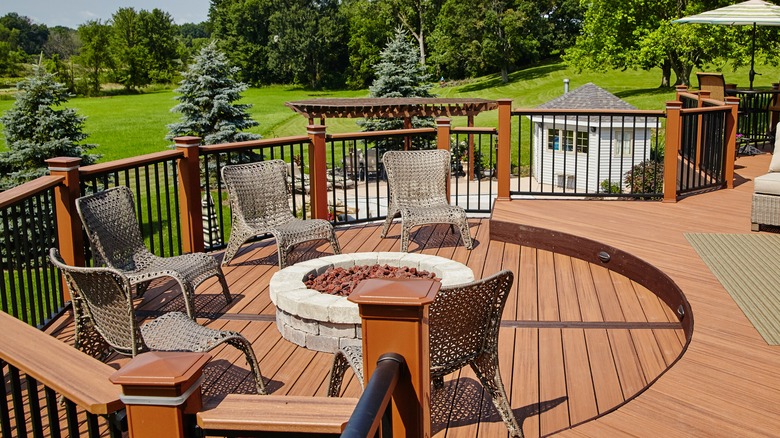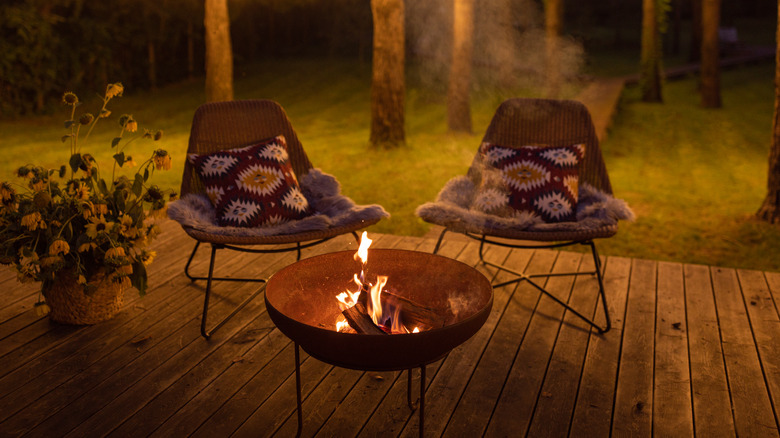Crucial Safety Tips To Consider When Installing A Fire Pit On Your Deck
So you've decided it's a good idea to start a fire on your wooden deck, or maybe your composite deck that contains flammable gases like butane and propane. What could go wrong? Well, probably nothing at all, especially if you follow some basic guidelines for safety installing and using a fire pit on a deck. Most of these are common sense, and few are difficult to comply with.
But first, let's make sure putting a fire pit on your deck is okay with the real authorities. No, not your dad or that neighbor who can give you the side-eye from any position. You need to make sure your municipality currently allows outdoor fires, which you can usually verify with your local fire department. It's also important to discuss the matter with your homeowner's insurance provider. According to Allstate, failing to notify your insurance company about the fire pit might mean damages won't be covered. A permanent, detached fire pit might need to be listed and covered as a separate structure, while a portable fire pit is typically covered as a personal belonging and might precipitate an increase in personal property limits.
After all that's out the way, step one of installing a fire pit on your deck is figuring out where to put it. You might not have a lot of good options, and in fact you might not have any good options at all. And unfortunately, you can't use any of the bad options.
Setting up a deck fire pit
Your fire pit should be at least 20 feet from any structure, including your home, and at least 3 feet from anything flammable or combustible. The planned location on your deck has to be level and stable, and it must be able to support both the pit and the required fire pad underneath the pit (never put a fire pit directly on your decking). Your fire pad can be a commercially available model, or a DIY barrier made of pavers or another acceptable surface like concrete, brick, or stone. Expect some discoloration of the pavers, which is one reason placing a firepit on your patio paver backyard could be a mistake. There should also be no overhanging branches or structures within reach of sparks, embers, or flames. It's safe to put a fire pit underneath your backyard pergola as long as you're aware of the limitations.
Keeping those embers and sparks contained is the job of another required bit for wood-burning fire pits: a spark screen. You must also have a fire extinguisher, a fire blanket, or a good supply of water nearby to put out any unwelcome flames. To be sure you're getting the right extinguisher, brush up on everything you need to know about buying them for your home. You can relax very slightly if you're planning a propane or natural gas fire pit since they're a little safer than their wood-burning cousins.
Tips for safely using a deck fire pit
As you might have noticed in college, a sturdy building and smart people are no match for a single person not paying attention. When it comes to a deck fire pit, the direct, in-person attention of an adult is critical — you simply can't handle every eventuality with precautions. Windstorms blow in, tree limbs fall, dogs behave as if they're being pursued by villagers with pitchforks, and maybe villagers with pitchforks are pursuing something near your fire pit. None of this happens on a schedule, and if you're not there to react to it, the forces of chaos will control what happens next. The most important thing is keeping burning things separate from things you don't want burned, like leaves, pine needles, cans of gasoline, children, and pets.
Of course, the attention of an adult is useless if they don't know what to do. Don't use accelerants like gas to start fires (this is what arsonists use). Use seasoned firewood, but don't use any firewood at all during high winds or a severe drought. When you're done, douse the fire with water to put it out thoroughly, then dispose of the ashes safely after they've cooled — usually 24 hours or so.


